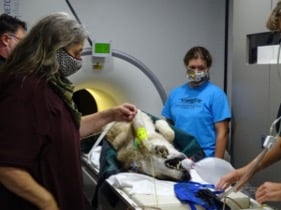Ambassador wolf receives MRI procedure at Ely hospital
Prognosis isn’t yet clear for Boltz, an 8-year-old gray wolf
Contact:
Chad Richardson, Communications Director
International Wolf Center
Office: 763-233-7132
chad@wolf.org
Additional photos available on request
 FOR IMMEDIATE RELEASE – Once the doors closed at the Ely Bloomenson Community Hospital MRI unit on Sept. 15, a special patient was wheeled into place for a unique MRI. This patient was a wolf.
FOR IMMEDIATE RELEASE – Once the doors closed at the Ely Bloomenson Community Hospital MRI unit on Sept. 15, a special patient was wheeled into place for a unique MRI. This patient was a wolf.
For the first time in the history of the International Wolf Center and the first time at the hospital, an ambassador wolf from the Center was given an MRI. The procedure was done to help identify some lingering health issues that are negatively impacting Boltz, an 8-year-old gray wolf.
“We’re so thankful that the Ely Bloomenson Community Hospital worked with us on this really unusual request,” said the Center’s wolf curator, Lori Schmidt. “It is not uncommon for us to have x-rays taken at the Ely Veterinary Clinic, but an MRI is not available there. This contribution to helping diagnose Boltz was critical.”
The MRI came about thanks to an initial phone call from Dr. Woerheide from the Ely Veterinary Clinic, followed by hours of logistical details on how to keep a wolf safely sedated for the duration of the procedure.
“She made the call to the hospital and was able to coax them into seeing what a benefit this could be for all the parties involved,” said Krista Harrington, the Interpretive Center Manager. “The closest animal MRI is in the Twin Cities, so we could not have done it without her and the Ely hospital.”
The hospital said it is proud of its contribution.
“While certainly an unusual request for a different kind of patient, we were excited, challenged and blessed by the opportunity to help with Boltz’ diagnosis and eventual care plan,” said EBCH’s Diagnostic Imaging Team Leader, Victor Aime. “I had two planning meetings with Dr. Woerheide to consider the challenges of an MRI on a sedated wolf. The meetings paid off with a flawless experience. It couldn’t have gone better! Ely-Bloomenson Community Hospital is proud to have been a participant in this collaborative effort with the International Wolf Center and Ely Veterinary Clinic for the benefit of Boltz.”
Dr. Woerheide figured she had nothing to lose in asking the hospital.
“It didn’t hurt to ask,” Woerheide said. “We thought they were probably going to say, ‘No, we don’t want a wolf in our very expensive machine,’ but Victor was open to helping out. I met with him in person and we talked it all through. We just made a plan and made it happen.”
Staff at the International Wolf Center were able to get Boltz sedated during the day and then transported him to the hospital in a crate. Woerheide was in the back of the truck monitoring Boltz on the short drive to the hospital. When they all arrived, he was loaded onto a lift and taken into the MRI trailer.
Everything inside took about 90 minutes. During the MRI, hospital staff carefully studied what was showing up on their monitors. It’s safe to say that these results looked much different than what they normally see.
“The staff was comparing the anatomy of wolves to people and asking a lot of questions,” Harrington said. “They were asking things like ‘How many lumbar vertebrae do wolves have? What were the presenting symptoms?’
“They explained a lot of what we were seeing on the scans as they happened — where the spinal cord was, the various parts of the brain, the sagittal crest, the jaw and other skull and spine features.”
Once hospital staff were finished with the MRI, the images were burned onto a disc. Those images were emailed to the University of Minnesota Neurology Department, which conferred with Dr. Woerheide on the results. Nothing conclusive has been found yet, so additional tests are being done to get a diagnosis for Boltz.
“Wolf care staff are closely monitoring Boltz with the aid of onsite surveillance equipment and daily review of video to assess his response to treatment, Schmidt said. “We are hopeful we’ll have a conclusive diagnosis and prognosis soon.”
The International Wolf Center advances the survival of wolf populations by teaching about wolves, their relationship to wildlands and the human role in their future. For more information about the International Wolf Center, visit wolf.org.

